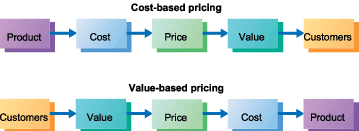Cost-based versus value-based pricing
Value-based pricing reverses this procedure. The company sets its target price depend on customer perceptions of the product value. The targeted price and value then drive decisions regarding product design and what costs may be incurred. As a result, pricing begins with analyzing consumer requirement and value perceptions, and price is fix to match consumers' perceived value.
A company by using value-based pricing must find out what value purchaser assign to different competitive offers. Although, measuring perceived value could be hard. Sometimes, consumers are also asked how much they would pay for a fundamental product and for each benefit added to the offer. Or a company may conduct experiments to test the perceived value of several type product offers. If the seller charges more than the buyers' perceived value, the company's sales will be suffered. Various companies overprice their products, and their products sell weakly. Other companies are under price. Under priced products sell very good, but they manufacture less revenue than they would have if price were go up to the perceived-value level.

At the time of the past decade, marketers have noted a basic shift in consumer attitudes toward price and quality. Various companies have changed their pricing schema to bring them into line along and consumer price perceptions and changing economic conditions. The most excellent way to hold your customers is to regularly figure out how to give them more for less."
Therefore, more and more, marketers have adopted value pricing strategies-by offering only the right combination of quality and good service at a fair price. In various cases, this has involved the introduction of less costly versions of established, brand-name products. In various business-to- business marketing situations, the pricing challenge is to search ways to maintain the company's pricing power-its power to maintain or even grow up prices without losing market share. To hold pricing power-to get away price competition and to justify higher cost and margins-a firm has to retain or build the value of its marketing offer. It is especially true for suppliers of commodity products, which are characterized by little differentiation and intense cost competition. In such type of cases, various companies adopt value-added strategies. Instead than cutting prices to match competitors, they linked value-added services to distinguished their offers and therefore support higher margins.